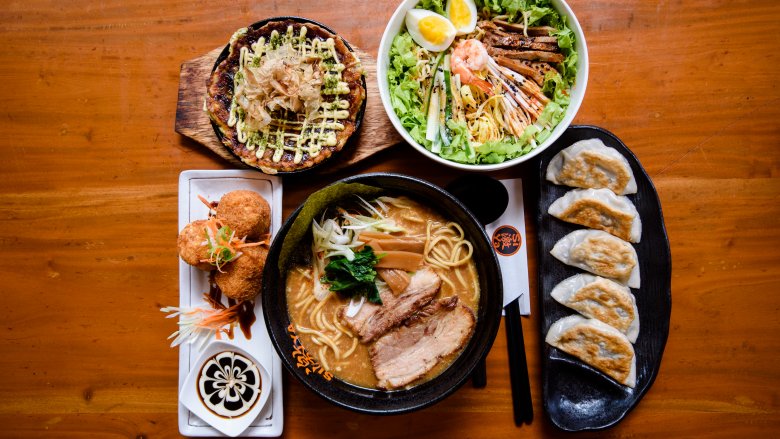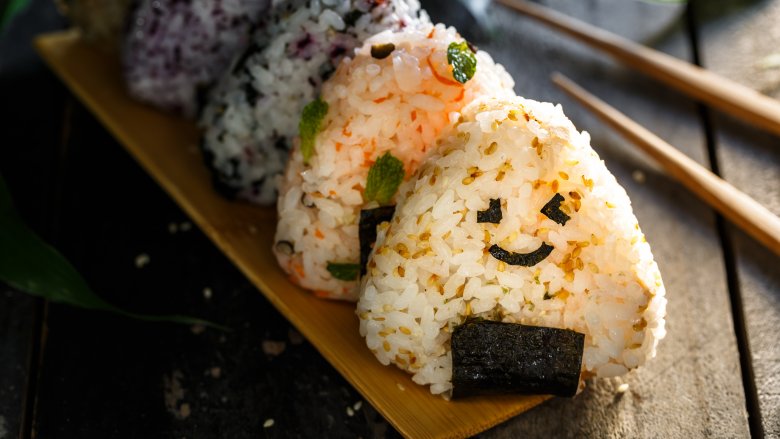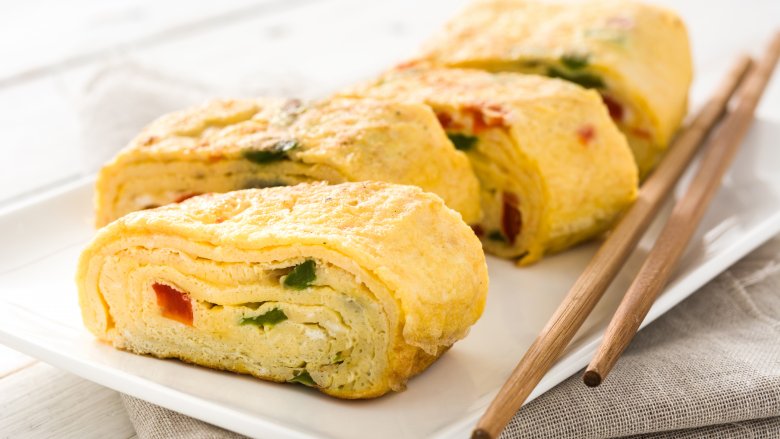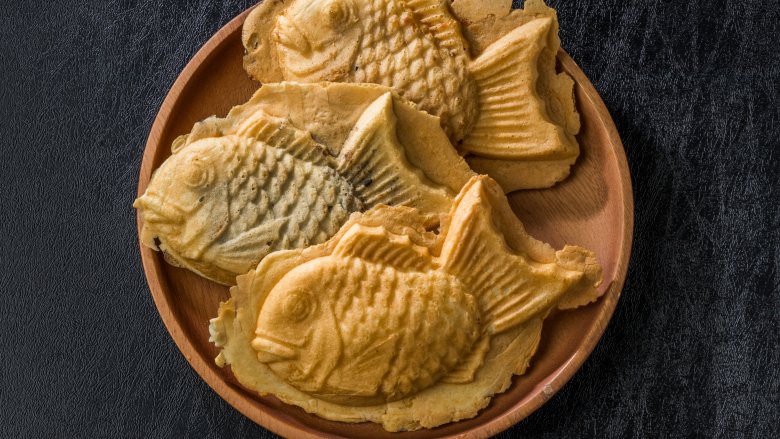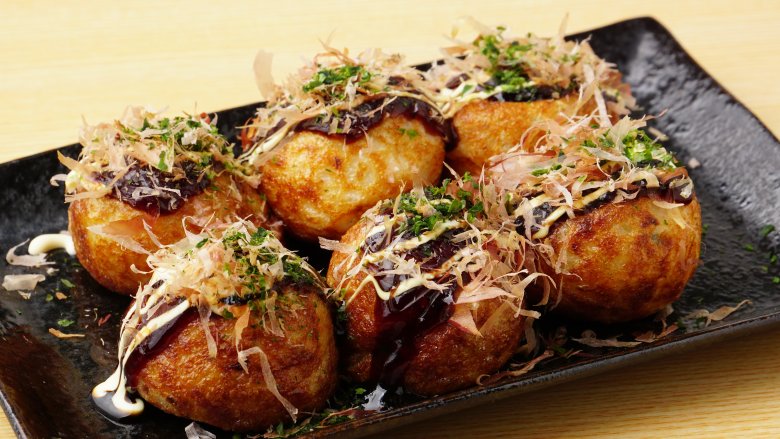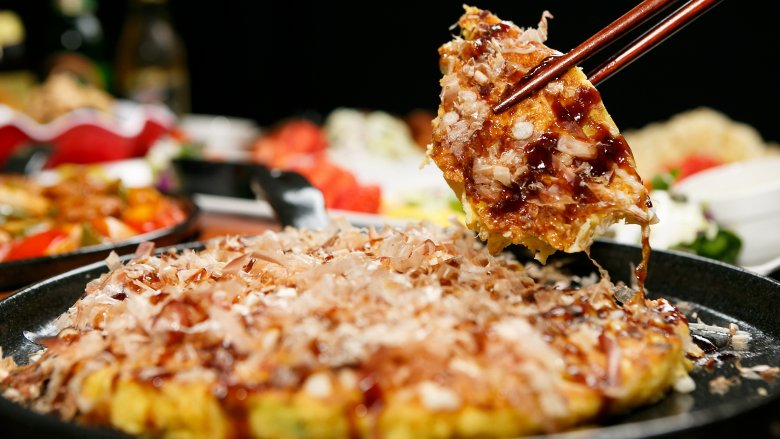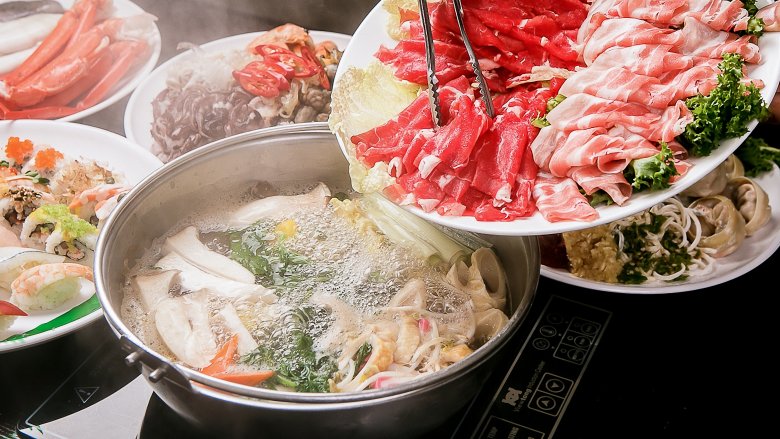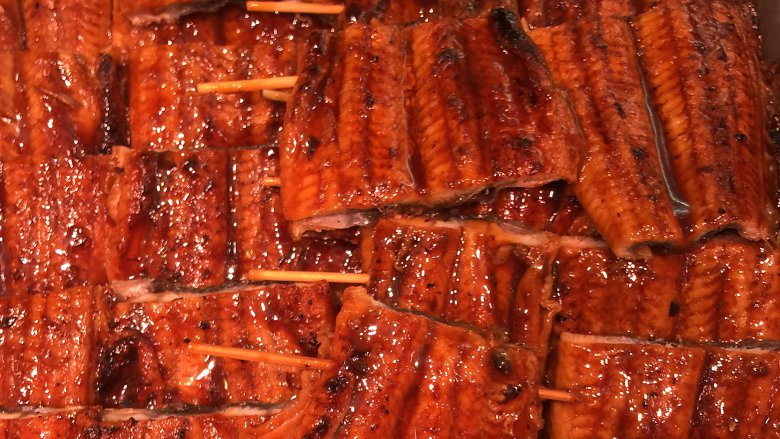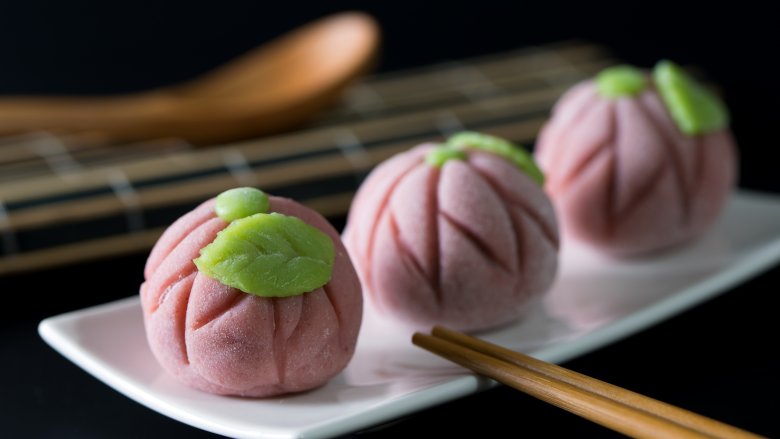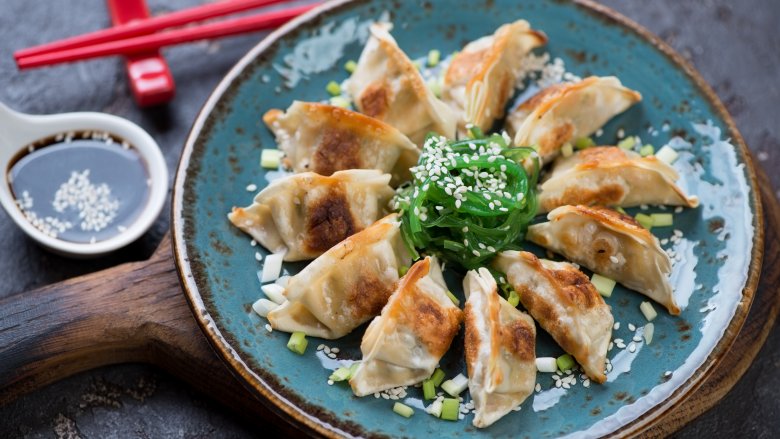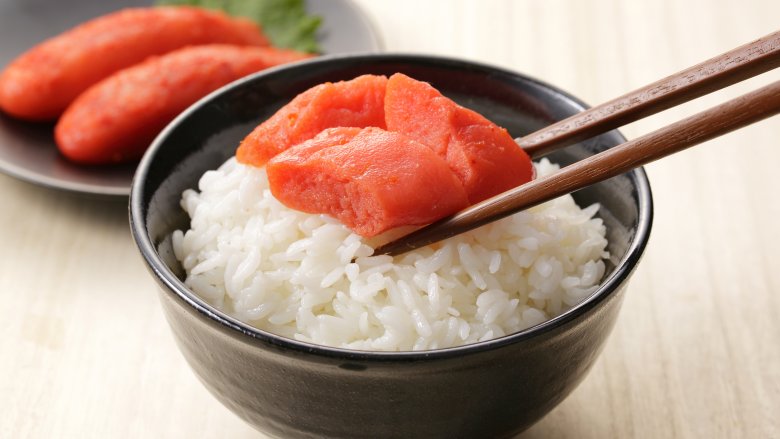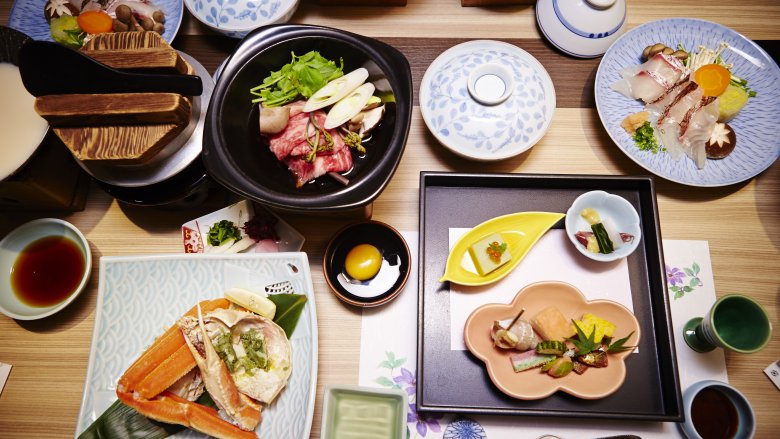Amazing Foods From Japan That We Need In America
To westerners, Japan might well be the closest thing we have to an alien planet. From their culture to their mannerisms to even the strange, beautiful country itself, Japan is a place you could visit a thousand times and still always find something new. That goes doubly for the food, of course.
What is Japanese food to us? In America, sushi is the big hitter, as is sashimi, its rice-less variant. We've got noodles, sure, and soy sauce and teriyaki are almost ubiquitous throughout American cuisine. These, however, are only the smallest taste of what Japan really has to offer. It's a veritable "Galapagos" for food, filled with all manner of incredible dishes which, while unusual to us, are nothing at all out of the ordinary for the locals. Octopus, eel, sweetbreads, rice balls, pollock roe and more are on the menu here — or we wish they were, at least.
A classic snack
Onigiri is everywhere in Japan. It's probably the simplest thing on this list, too, but its malleability means that finding the food onigiri will open up a whole new world for you to explore. It's basically a clump of sticky white rice formed into a triangle (or cylinder) and wrapped in seaweed. Originating in feudal Japan, onigiri is easy to make and immensely practical — not least because it doesn't actually require chopsticks to eat.
The best thing about this little bite of rice is that it can come in a load of other varieties. You can find it made with sesame rice, garlic butter rice, fried rice or whatever kind you like, with any number of garnishes and fillings included (such as bacon, adzuki beans, salmon or ground meat) to spruce it all up. Walk the streets of Japan and you're bound to find some decent onigiri eventually, but you'll probably have to find a specialist outlet to get it here. Either way, we recommend you give it a go — and, once you do, get customizing. The only limit is your imagination.
Bite-sized omelettes
Tamagoyaki, like basically everything in Japan, is a strange simulacrum of something you're already probably familiar with. You see, it's an omelette — kind of. It's made by beating eggs in a bowl and frying the contents in a pan, just like how you might make scrambled eggs or an omelette. It's even seasoned, albeit with things like soy sauce, sake, rice vinegar and bonito flakes rather than, say, salt and pepper.
The big difference between tamagoyaki and the western omelette, however, is that the former is folded over again and again using a special rectangular pan, until, eventually, it becomes a log, which can then be sliced into bite-sized pieces. The end result is a tiny little piece of eggy goodness that kind of resembles a floppy bar of gold. Okay, we're not selling that very well. But they do taste good. Tamagoyaki is eaten for breakfast, as a side for other meals (such as inside bento boxes) and with sushi.
Every kind of pastry
Kashi pan is the name given to a special kind of Japanese pastry. It's essentially sweet bread with an added filling or topping, which acts as a suitable snack or a breakfast food for the discerning Japanese man or woman on the go. The original variant, which is known as the an pan and stuffed with a bean jam, was popularized in the middle of the 19th century. Next came the jamu pan, which was filled with apricot jam. By the second half of the 20th century, the dish had begun to see all sorts of alternative variations spring up around Japan.
These include the meron pan (crispy on the outside, soft on the inside), the kurimu pan (stuffed with custard cream), the koshian pan (loaded with poppy seeds) and the korone (which is shaped like a seashell and filled with chocolate cream). Not bad for a country that didn't know what bread was until the 1500s, right?
The octopus balls that inspired a theme park
Takoyaki, not to be confused with tamagoyaki (sheesh, languages), translates literally to grilled octopus. It's a street food in Japan and consists of minced octopus with tempura, pickled ginger and green onion cooked in a wheat batter and brushed with its own special sauce. Takoyaki has been a local favorite in Japan since the 1930s, when it was invented by an Osakan resident called Tomekichi Endo. Since then, it's become immensely popular — special cast iron molds are sold to help make it and, in a development that would be surprising if this was anywhere but Japan, a takoyaki-themed food theme park has even opened in Odaiba, Tokyo.
As you might expect, variety is the name of the game here, and different types of takoyaki include those made with soy sauce, citrus vinegar, sesame sauce or vinegared dashi. So there you have it: France has baguettes, Italy has pizza, Japan has cephalopod balls. Who'd have thunk it?
Okonomiyaki: the everything pancake
Yes, it's a long word. We know. But — trust us — it's really just a better kind of pancake. "Yaki," as you might have figured out by now, means "grilled," whereas "okonomi" means "to one's liking." What you've got here is basically an all-in-one pancake explosion of whatever you've got left lying around. It can be filled with anything from cabbage to octopus to shrimp, pork, yam, kimchi — or practically anything else. A number of special okonomiyaki restaurants in Japan even allow customers to choose their own ingredients and cook their meal themselves.
Even with all the choices you have when deciding on the ingredients for your okonomiyaki, there are only two particular ways of cooking it. The Kansai Style (or Osaka Style) posits that the ingredients should be cooked along with the battered pancake whereas the Hiroshima Style insists that they be cooked separately and then added on afterwards — with a bed of yakisoba noodles to accompany it.
The secret love child of a fondue and a hotpot
Shabu shabu, aside from being by far the easiest name to remember on this list, is Japan's version of the hot pot. It has one major difference to the type we know and love, however: with shabu shabu, the ingredients are cooked during the meal rather than prior to it, making it more of a fondue/hot pot hybrid than anything else.
The broth that acts as a base for shabu shabu is made from seaweed and gathers flavors over the course of the meal as the various ingredients are cooked and dipped into the sauce. Those ingredients might include meats, such as beef, pork or seafood, as well as vegetables and tofu. You take a slice of meat or vegetable and submerge it in the broth, then dip it into some sauce, before eating with a side of rice. Once you're done, the leftover broth, now at its most flavorsome, is eaten as a soup — it's that simple and that delicious.
Eels. Yes, really.
What is unagi? Depends on who you ask. Ross from Friends will tell you that it's a state of total awareness which allows its user to defend against surprise attacks. (He's wrong.) Ask the Japanese and they'll tell you that it's eel. The "kabayaki" refers to a method of grilling in which the ingredient (that's the eel, here) is butterflied and then marinated in soy sauce, sake, sugar and other seasonings. Grilled eel has been a Japanese favorite since the 17th century due to the fish's relative affordability. Nowadays, however, they're a bit pricier and tend to be seen more as a luxury.
This dish varies based on region. In Kansai, you slit the eel down the middle before grilling it, with chewy, crispy results. In Kanto, however, it's steamed first to diminish any excess fat, making for a more tender eel. Either way, unless you're a 19th century cockney, you're not likely to be very familiar with eel as a food (and even they ate them jellied, for some reason). Trust us, though — they're nicer than you think.
The perfect treats for your tea
Oh, you know the Japanese do desserts like nobody else. You can just tell they're going to have something amazing up their sleeves, right? Enter wagashi: a traditional Japanese confection with a vital role in that culture's tea ceremonies. Taking tea in Japan is more about aesthetic than anything else, and a good ceremony is colorful, pretty and neat. Wagashi has two purposes — firstly, it adds a sweet touch to the affair, counterbalancing against the bitterness of the tea. It also, however, adds to the artistry of it all.
Wagashi can be made from rice, gelatin, beans, flour, sugar and any number of different ingredients. Because they're small and colorful, however, they're also perfectly suited to completing that aesthetic perfection that all tea ceremonies demand. Next time you're reaching for the brownie mix, why not think twice and go for something a little bit healthier and a lot more flamboyant? You won't regret it.
Gyoza: not just dumplings
Gyoza are dumplings filled with a number of different types of ingredients, including various types of ground meat and vegetables — you may recognize them as pot stickers. They actually originated in China, but have gained a steady popularity in Japan. Your basic gyoza contains ground pork, chives, onion, cabbage, ginger, garlic, soy sauce and sesame oil, but, of course, Japanese chefs have learned to improvise in terms of how they're actually made.
You've got your standard yaki gyoza, which is pan fried and served with the crispy side up. Sui gyoza is boiled and served in a light broth. Age gyoza is crispy and deep fried. Whichever kind you choose, they're usually eaten with a side of dipping sauce and a dash of chili oil. You can find them in ramen shops, Chinese restaurants, casual dining places and even some specialty establishments that specifically sell gyoza. And if you're after the best gyoza around, try heading to Utsunomiya or Hamamatsu: they're the cities who claim to make Japan's finest.
Fish eggs like you've never known before
Put down the caviar, everyone, there's a new kind of fish egg in town. Well, not in town. In Japan. Mentaiko is a spicy roe of pollock which originated in Korea and became big in Japan after the second World War. It's made by marinating pollock eggs in chili, sake, konbu (which is edible kelp) and yuzu citrus, before being fermented for a few hours. You can find mentaiko sold with or without its natural membrane.
Mentaiko is actually used most commonly as a filling for onigiri, but it's also often served with salad in Japan, can be a filling for various types of bread and is even occasionally eaten with spaghetti. The city of Fukuoka is the country's biggest producer of mentaiko (being the closest to Korea), and is home to around 300 producers of the food.
The world's finest meal
Kaiseki isn't actually so much a food as it is a way to eat. Described by CNN as "the world's finest meal," it's an intricate, beautiful and expensive meal which was originally enjoyed by the Japanese nobility. The core purpose of kaiseki is to imbue a sense of respect and comfort on the diner. Of the many courses which comprise this meal, you're likely to find an appetizer served with sake, a simmered dish, some sashimi, hassun, which is an expression of the current season's aesthetic through food, a grilled course, and a rice dish.
The ingredients are specially chosen based on the time of year and the location in which it's served, with foraged foods often making up a significant part of the meal. Not only this, but every kaiseki chef has his or her own style of cooking and values which are to be imparted on their guests, meaning no two kaiseki will ever be alike. It's about as Japanese as Japan gets, and the closest thing you'll find to it here is likely to be a Michelin-starred experience or haute cuisine at some fancy restaurant. Let's face it, though — kaiseki is nothing but utterly unique.
